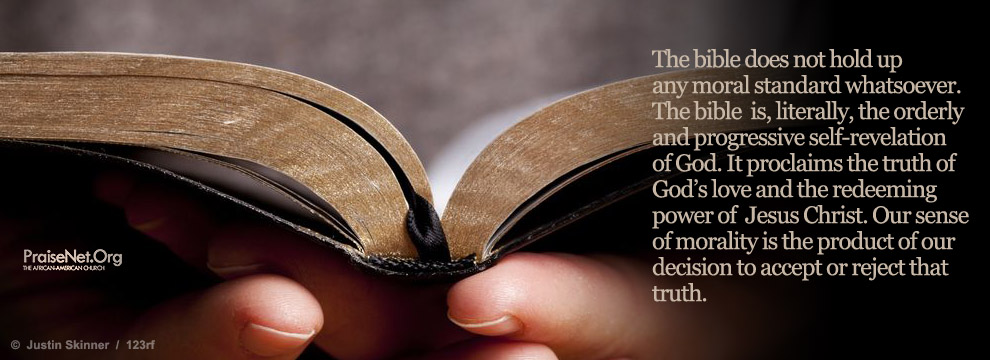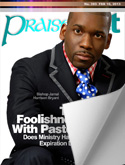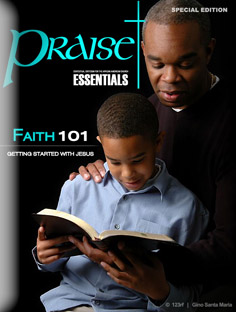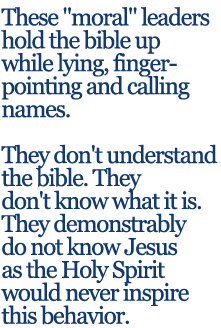The Bible 101
What It Is, How To Read It
The Word Was With God
The Bible is a collection of sacred texts that were written by
men under the inspiration of God. The very first Bibles had 80
books in them, but over the years these books were pared down to
66 books we use today. The excluded books were ultimately judged
less reliable and less provably authentic. If you wanna go way
deep into the origins of the Bible, you can read about that
here.
In Theology class, they teach you that the Bible is the orderly
and progressive self-revelation of a divine God. The Bible is,
literally, the Word of God and God inhabits that Word (John
1:1). To read the Bible is to commune with that Word. To commune
with that Word is to fellowship with God. Got that?
It's just a book. It is a block of paper sewn together between
two covers. There is nothing mystical about it, nothing magic
about it. I use a bible to prop up my synthesizer sometimes when
I've set up my keyboard on an uneven surface. I see some people
clutch their chests when I do that, but I ask them, what better
foundation could there be for my music than God's Word?
Look, the book itself is only a book. It isn't the book that is
holy but the words in it; the meaning and the eternal power of
those words are holy, not the paper and ink. Swearing on this
block of paper, as they do in courtrooms all over America, is
completely wrongheaded and anti-scriptural (Jesus teaches us not
to swear by anything, Matthew 5:34).
What's It About?
The Bible tells us The Story of Jesus. From Genesis, the very
first book, to Revelation, the very last book, everything in the
Bible fits together, like divine Lego bricks, to tell a larger
story: the story of Jesus. Jesus represents mankind's
reconciliation with a divine God, and the Bible has but one
purpose: to bring us closer to God.
The Bible is set up into sections: Law, Prophecy, The Writings,
The Gospels, and Letters, which we call Epistles. 90% of what we
do in church on Sundays is based on the Gospels and the
Epistles, letters written by early church leaders that form the
basis of how we express our faith in God (what we call
“doctrine”).
There's a lot of ways to tackle this book. But if you are new to
it, the worst way to do this is to try and comb through Genesis
to Revelation without being familiar with the book and how it is
designed to speak to you.
How Is It Organized?
The Bible is not a book. The word "bible" actually means "many
books." The Bible is a collection of works from various
individuals writing under the direction and influence of the
Holy Spirit. LeeAnn Bonds,
BellaOnline's Bible Basics Editor,
put it this way:
The part God wrote begins at Genesis 1:1, and ends at Revelation
22:21. You probably know that the chapter and verse numbers were
added by people. They make it easy to find a certain section of
Scripture, but the divisions created by the numbers are often
arbitrary, and sometimes do the reader a real disservice. So,
use them to find your way, but don’t place any importance on how
they chunk up the message.
The Bible comprises two main sections: The Old Testament and the
New Testament. Testament means a covenant between God and
the human race. The Old Testament tells about God’s covenant
with the Jews, and the New Testament tells about Jesus, and the
new covenant He put in place. That’s an enormous
oversimplification, of course, but we have to start somewhere.
The Old Testament contains 39 books. They’re arranged in groups
according to type of content: History, Poetry, and Prophecy.
These are general descriptions, with types of content
overlapping in all the groups. You might like to memorize the
books in the order they occur. To make this easier, you can
divide them into sets of five and twelve, thus:
History (17 books)
-
5 Law: Genesis, Exodus, Leviticus, Numbers, Deuteronomy (Also known as the Torah or the Pentateuch. These present God’s laws, but also contain lots of history.)
-
12 Historical: Joshua, Judges, Ruth, I & II Samuel, I & II Kings, I & II Chronicles, Ezra, Nehemiah, Esther (These tell the story of the Jews and Israel, mainly.)
Poetry (5 books)
-
Job, Psalms, Proverbs, Ecclesiastes, Song of Solomon (Poems, songs, and wisdom literature.)
Prophecy (17 books)
-
5 Major Prophets: Isaiah, Jeremiah, Lamentations, Ezekiel, Daniel
-
12 Minor Prophets: Hosea, Joel, Amos, Obadiah, Jonah, Micah, Nahum, Habakkuk, Zephaniah, Haggai, Zechariah, Malachi.
The New Testament has 27 books. They are organized like this:
Gospels (4)
-
Matthew, Mark, Luke, John (These tell the story of Jesus’ life, death, and resurrection)
History (1)
-
Acts (The Acts of the Apostles is the long name, describing the beginning of the Church)
Epistles (21)
-
Romans, I & II Corinthians, Galatians, Ephesians, Philippians, Colossians, I & II Thessalonians, I & II Timothy, Titus, Philemon, Hebrews, James, I & II Peter, I, II & III John, Jude (Letters to and from leaders and churches, mostly)
Prophecy (1)
-
Revelation (The Revelation of Jesus Christ, telling about the end of the world as we know it, and then the happily ever after part)
Where Do I Start?
In terms of what we do on Sunday mornings and how we should be
living our lives, I suggest you read at least two chapters a
night. Two chapters is a cake walk. I could train a monkey to
read two chapters a night. I know we can all do that.
Start with the Gospel of Mark. Mark is what we call a Synoptic
Gospel, a reliable text that summarizes the story of Jesus. Mark
was likely written as a missionary book, what we call a tract,
for new converts to Christianity. It is simple and easy to
understand, fast paced and straightforward. And, at 16 chapters,
you'll get through it in a week.
Then jump over to Philippians. The church at Philippi was one of
Paul's favorites, and he wrote this simple and straightforward
letter to them while he was in prison. Philippians encourages
the new believers to know we can do all things through Christ
(Philippians 4:13), and places the responsibility for our
salvation squarely on us (2:12).
Then try the Epistle of James. James was Jesus' biological
brother, a leader in the Jerusalem church. His epistle is,
likely, the most important to (and, often, the most ignored by)
the Black church as it deals almost exclusively with Christian
conduct, mainly with how we use our tongue and how we treat one
another.
Despite the legalistic do's and don'ts you've grown up hearing
from here and there, if you actually read the Bible, you will
see the main thrust of Jesus' ministry was to get us to become,
well, better people than what we are. For us to learn how to
love one another the way God loves us. James deals with issues
of genuine faith as opposed to a practiced religion, and this
book is vital to understanding what church and Christianity is
supposed to be about.
After James, swing back to Acts. Acts is like The Gospels Part
II. The Disciple Luke, a historian with a great attention to
detail, picks up the story of Jesus from where it leaves off in
the Gospels, and tells the story of the early Church and,
notably, Paul.
Paul
Next to Jesus Himself, Paul is the dominating figure of the New
Testament. Much of our understanding of doctrine comes from his
letters, what we call The Pauline Epistles. To understand what
we do and why we do it, you have to get an idea of who Paul was,
both before his conversion and after. He was, in many ways, the
first pastor (though the Disciple Peter is, officially, the
first pastor, Matthew 16:18).
What makes Paul interesting is how deeply flawed an individual
he was. The more you read about him and the more you read his
words, a consistent theme emerges: Paul never sets himself up as
being better than you. Or better than anybody. He is far from
perfect. Even after conversion, Paul is still very legalistic (a
guy who enforces The Rules, whatever they are). He and his best
bud Barnabas parted ways because Paul didn't like this guy
Johnmark that Barnabas was partnering with.
There was a lot of things wrong with Paul, a lot of
imperfections. Which is what makes his writing all the more
credible because he is not some perfect holy man. He is a human
being, just like you. Struggling to make sense of things, just
like you. The Book of Acts tells his story and completes the
historical tale begun in the Gospel of Mark.
Then, finish up with Paul's letter to the Romans. This was a
letter of introduction Paul sent ahead of his visit to the new
church in Rome. Romans provides the meat of our doctrinal
belief: of how we express our faith in Christ. Romans teaches us
how to be saved and how to stay saved and why that's important.
Which Version Do I Read?
As for which version to read: please don't let yourself get
caught up in arguments over which version of The Bible is legit.
Church people love to squab about things, and this has
traditionally been a heated argument. Most Black Church Folk
believe the King James Bible is the only reliable version of the
Bible. But, if you ask them why they believe that, most couldn't
tell you. They know absolutely nothing about the KJV or where it
came from or why it is more reliable than, say, the New
International Version, The New Living Translation, The New
American Standard Version, or many other versions.
I've actually been told the KJV is the most reliable because,
“That's the Bible the Disciples carried!” The New Testament did
not exist in the days of the Disciples, and the average person
was not allowed to carry a copy of the Old Testament, called The
Torah, around with them (remember, this was long before printing
presses: each copy of the Torah had to be written out by hand).
Nobody carried a Bible in those days.
Just find yourself a version you can read. A version that you
WILL read. It's a good idea to read an official translation as
opposed to a paraphrase. A paraphrase is a version based on the
King James and translated into modern language. A reliable
translation is a version derived from the original Greek and
Hebrew manuscripts.
I strongly recommend The NIV Student Bible by Zondervan. This
wonderful, easy-to-read translation contains hundreds of study
helps and explanations along the way, written by award-winning
Youth Bible Scholars Philip Yancy and Tim Stafford. Years ago
these men edited a tremendous youth bible called The Way, and
the NIV Student Bible is a successor to that work. Our column,
Love, Sex & The Whole Person, is derived from Campus Life
Magazine, a teen and young adult Christian life magazine founded
by Yancey and Stafford and published by Christianity Today
International.
However you do it, just dive in. The Bible is a rich and vibrant
record that speaks directly to your heart and brings you closer
to God. The more you pick it up, the closer you get to God. Skip
a TV show (or even half a TV show) and give yourself two
chapters a day. You'll be amazed at the difference it will make.
Christopher J. Priest
7 September 2003
editor@praisenet.org
TOP OF PAGE





